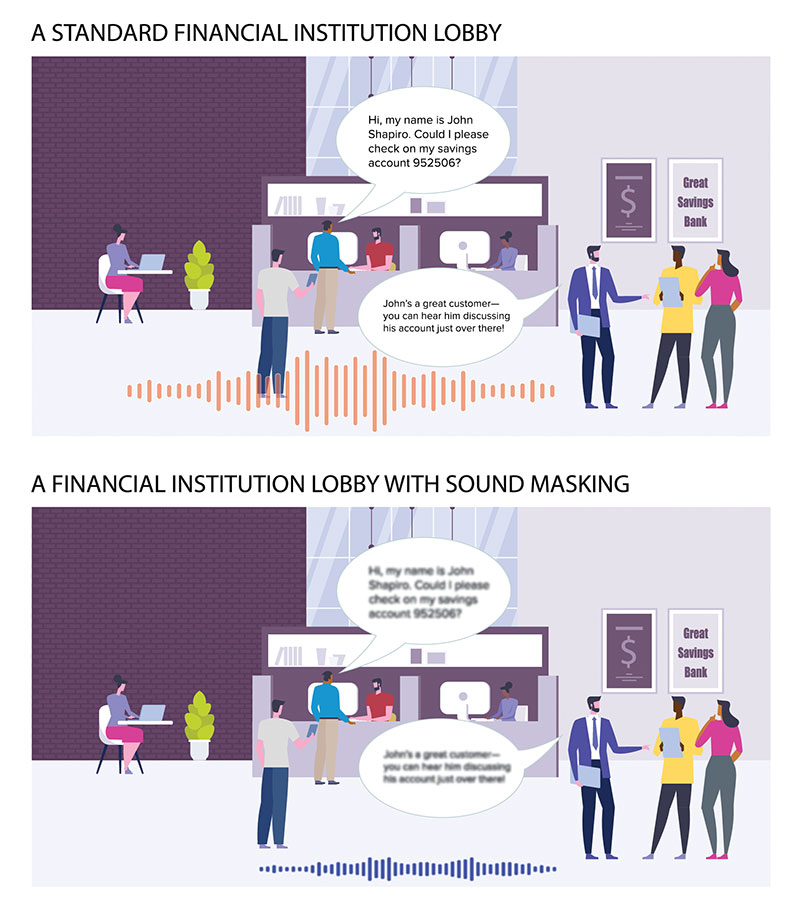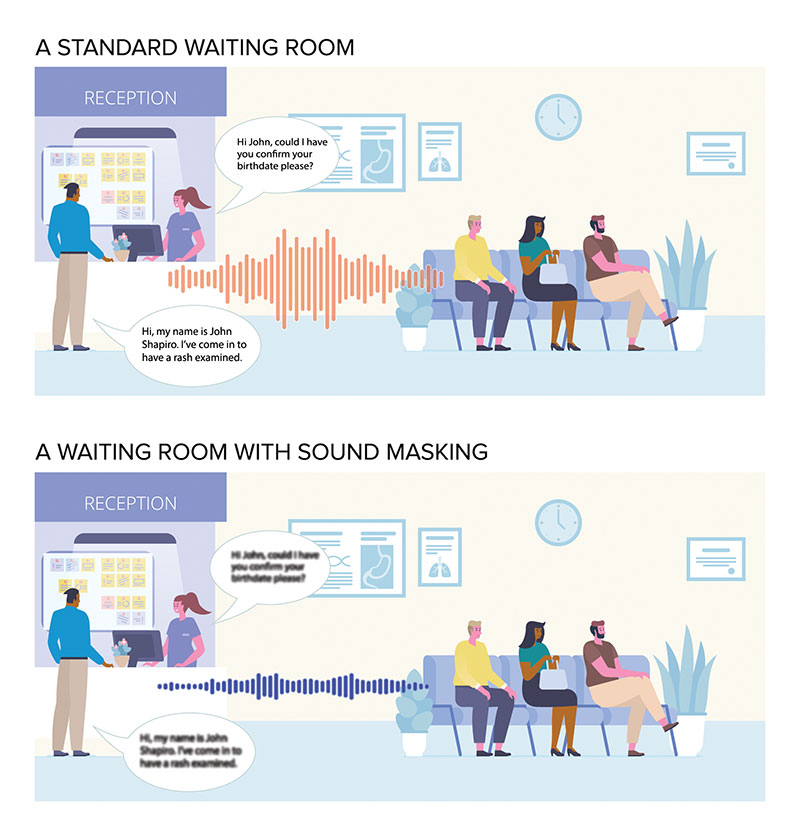Although frequently cut from building budgets, it has become increasingly indispensable.
What’s worse: a room full of distracting chatter and clatter or one encumbered by the oppressive weight of too much silence?
Truthfully? Both. Legally? Also both.
At a time when privacy and security are more important than ever before, how sound is managed in any public space is not only important, but also, in fact, the law.
Around the globe, more and more often, functional spaces are being designed to look good, work efficiently and offer a diversity of accessibility. What’s more, though, is that their sound acoustics are being thoughtfully planned, including the use of purposeful sound control or masking.
What Is Sound Masking?
Sound masking entails making an active acoustic effort to veil unwanted sound waves.
Granted, this is the most basic definition of sound masking. Beyond that, it’s about controlling noise to a positive end.
One of the most recognized examples of sound masking is a simple white-noise machine being used in an office setting. It provides just enough background sound so that employees can focus on their tasks without being distracted by conversations being had by those gathered around the espresso machine, as they debate last night’s episode of the current hit show.
In the best-case scenario, the white noise is evenly distributed around the room. In the worst-case scenario, you’re stuck in a hotspot where the artificial sound is deafening and distracting by itself. (Alternate worst-case scenario: You’re trapped in a cold zone where the sound barely reaches you, but where you hear every word about Bob’s trip to the dentist. Every word. Every time.)
Sound masking is not difficult, however, whether for newly designed spaces or when retrofitted into existing ones. When sound masking is properly planned and installed, its effects can be dramatic, not only for your staff’s productivity but also for ensuring privacy-law compliance.

Who (Or Where) Needs Sound Masking?
The need for sound masking varies from space to space. In some cases, it’s a “really nice to have”; in other instances, it’s a legal requirement.
Open Offices or Industrial Design Office Spaces: Noise affects employee productivity. The psychological effects of unwanted or disturbing sound in the workplace have been well documented in study after study. The Environmental Protection Agency (EPA) estimates that workplace noise adversely affects the lives of millions of people, resulting in complaints of stress-related illnesses, high blood pressure, hearing loss and sleep disruption that ranges from mild to serious.1
When a physical space offers little in the way of passive noise control—for example, an absence of high cubicle walls, private offices or softer, sound-absorbing materials—the effects on the personal well-being of each employee, as well as on productivity, can be profound.
According to a study by the University of California, Irvine, productivity can decrease by as much as 40 percent because of noise and distractions. The study found that employees are interrupted once every 11 minutes, and it can take as many as 23 minutes to get back on task.2
Industrial Environments: The ultimate goal of sound control is to hide unwanted noise. Industrial environments are peppered with repetitive sounds—everything from automatic doors, to elevators, to intermittent heating, ventilation and air conditioning (HVAC) systems, to full-on manufacturing equipment.
Although workers stationed at large and loud machines typically use personal sound-control devices such as noise-canceling headphones, office workers (or those in areas adjacent to machinery) can suffer secondhand concentration issues from residual sound.
After all, just because an area isn’t quiet doesn’t mean it wouldn’t benefit from intentional and effective sound masking. The use of sound control means exactly that: to control the frequencies, octaves, volume and consistency of noise in an area. It’s creating an acoustic environment that takes over the background in a manner that’s non-invasive.
Financial Institutions: Banks, credit unions, investment-services companies and other financial institutions are legally required to maintain strict information security for their clients so as to comply with the Gramm-Leach-Bliley Act (GLBA) of 1999.
GLBA requires companies that provide financial services, products or advice to apply protections to customers’ private or sensitive financial information, securing it against unauthorized access. That includes speech privacy.
Institutions that break this rule can face fines of $100,000 for each violation. Individuals can be fined $10,000 and serve prison sentences of up to five years. (That’s not to mention the ripple effect of a sullied reputation, which can spread through social channels like gossip on a telephone party line.)
Healthcare Providers: Health-information privacy is required by law through the Health Insurance Portability and Accountability Act (HIPAA) of 1996. HIPAA established national standards for the safety of protected health information (PHI). PHI consists of “individually identifiable health information”3 transmitted in any form or media, whether printed, digital or spoken.
Penalties of $100 to $50,000 can be levied for each violation, with a maximum of $1.5 million per year for violations of an identical provision. Beyond that, though, in today’s world, individuals are more concerned with identity security than ever before. A healthcare provider must go beyond the letter of HIPAA to maintain patient comfort and trust.
What To Expect When You Install Sound Masking
Whether you use the traditional method of broadcasting white or pink noise through carefully spaced, conical loudspeakers or the newer, more efficient (and dramatic) planar loudspeaker technologies, expect a response from the people who frequent the affected areas.When you make a change to a work area, it’s natural for those affected to react—some of them with enthusiasm and some of them hypercritically. As any seasoned office manager will attest, you simply have to be transparent about what you’re trying to achieve and clear about your expectations—and then stick to your commitment until everyone has a chance to adjust.
Initially, you can expect team members will be listening closely because they’re skeptical. At times, they might claim they can still hear conversations from across the room; usually, this is because they’re trying harder than usual to hear those conversations.
In the first week or two, people might complain that the sound masking is too loud. This response is also normal because you’ve introduced a new sound in an effort to mask other noises. Typically, after about two weeks, the new sound disappears into the background.
For a real test of this scenario, try turning off the loudspeakers randomly in the middle of the day after the system has been up and running for a few weeks. People experiencing this situation usually report an eerie quiet that makes them uncomfortable. You will be surprised by how dramatic an effect this might have. It also makes for a good test if you happen to schedule it for April 1.
Whereas files can be secured behind firewalls and doors can be protected with badge access, the waiting room remains a very tangible battlefield for health-information speech privacy. Healthcare professionals and patients discuss PHI in detail—not to mention contact information and billing—well within earshot of others. Those are potential finable breaches of
HIPAA requirements if sound masking is not used.
White Noise vs. Pink Noise
Sound comes in what is known as a power spectrum. Color terms are used to explain the differences in power between types of noise. The most commonly discussed and used in sound control are white noise and pink noise.
White Noise: White noise is sound energy that contains every frequency. Similar to how white light contains all the wavelengths or colors of the visible spectrum, white noise holds a flat frequency in any bandwidth. This neatly compares to “black noise,” which holds zero frequencies in a bandwidth—in other words, silence. Because of its flat, all-encompassing frequency, white noise is often perceived to be staticky.
Pink Noise: Pink noise is sound energy that contains every octave. It has power in wide bandwidths, and each octave has an equal amount of noise energy. As a frequency increases, the power per hertz in pink noise decreases (whereas, in white noise, it stays equal).
Professional Installation
Although several personal noise machines are available on the market that can undoubtedly be ordered and delivered within two days, no amount of guessing can replace the skills and knowledge that professional sound engineers possess.When the goal is to create a noise-neutral environment, free of distractions and Gramm-Leach-Bliley Act (GLBA) or Health Insurance Portability and Accountability Act (HIPAA) violations, it’s wise to contract with experts who can design, install and test your space efficiently and effectively. You’ll hear the difference, as will your employees, clients and patients.
Because of this, lower frequencies in pink noise are louder, creating the perception of even and flat sound, which is often thought of as lower and more soothing. In fact, some research suggests pink noise can have a positive effect on memory and sleep.4
Both white noise and pink noise are used to apply a constant volume of sound in order to cover up unwanted noise. Designing a sound-masking system properly means controlling this mix in a way that doesn’t cause distraction of its own.

Types Of Sound-Masking Deliveries
White noise, pink noise or any other color of noise has to be introduced into an area in a way that makes sense. When you are planning sound control for a space, you have two basic choices for how to deliver it.
1. Traditional Conical Loudspeakers: Typically, white noise or pink noise is introduced to an area via a system of intentionally spaced, traditional loudspeakers that project the noise downward in a conical form.
Because sound disperses conically from those loudspeakers, it is vital to space them close enough together to lessen the cold spots (where the effects of individual speakers might not overlap).
As mentioned previously, this also means engineering the sound levels in a way so that they don’t create hotspots where the introduced control sound is too intense, counteracting its intended purpose.
2. Planar Loudspeakers Harnessing Solid Surfaces: These loudspeakers also use white noise and pink noise, but as an immersive-audio sound-control system that harnesses planar-wave physics. It’s similar to that of the soundboard of a piano or the body of a stringed instrument. They turn any rigid, flat surfaces in a room—for example, drywall, ceiling tiles, windows or counters, all of which are hallmarks of modern and popular industrial-office design—into an acoustic wave amplifier that radiates evenly, providing a constant sound pressure level (SPL) across the entire listening space. And because these products can equally radiate all frequencies across existing rigid surfaces, they help intentional sound to diminish at a shorter distance.
For example, patients waiting in line to check in at a medical clinic can be standing closer to each other and not hear the personal information others are sharing at registration. Why? Because the planar loudspeakers reduce the sound much more dramatically over a shorter space. The experience for others, then, is of hearing muffled sounds. They know that someone is speaking, but they’re not able to tell what’s being said.
And because the white noise or pink noise is radiated equally across rigid surfaces, far fewer planar loudspeakers are required to cover the same space as compared to a solution using traditional speakers.
A few companies have developed planar-loudspeaker technology and made it available for installation. When done at the beginning of a build phase, it’s easy to create the exact acoustic environment you want.
Sound masking, however, is commonly cut from the initial budgets of new buildings; then, later on, it’s found to be necessary. This can lead to second-rate sound control that’s full of hotspots and cold spots, leaving sections of a space in worse shape than if they had no masking at all.
Although retrofitting traditional conical loudspeakers can be invasive, requiring time to fit and test many devices, a planar-loudspeaker system is relatively simple to implement.
Because it takes far fewer speakers to cover the same area, a planar system can be simpler, quicker and less expensive to install, even while offering superior performance.
Endnotes
1 www.epa.gov/clean-air-act-overview/clean-air-act-title-iv-noise-pollution
2 www.mytechdecisions.com/audio/worth-investing-sound-masking-technology
3 www.hhs.gov/hipaa/index.html
4 www.time.com/4694555/pink-noise-deep-sleep-improve-memory